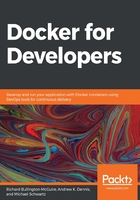
Summary
In this chapter, we introduced Docker Compose as a superior management tool for managing and running a complex system of containers. We described several useful docker-compose configuration file options that allow us to specify ports to expose, local networking, and local volumes. We exploited the docker-compose tool's inheritance capabilities as well.
A critical part of using Docker is the development cycle. We typically edit, build, run, and test each cycle—then repeat. The size of images, as well as the time spent building, publishing, and downloading them, can be strategically reduced.
We also explored some alternatives to using .sh scripts and docker-compose. These are a natural next step in your Docker education as they provide facilities for deploying your orchestrations to swarms or clusters of servers in production or for testing.
The next few chapters go into detail about how to deploy your applications and how to implement continuous integration and automated testing. After that, we will cover security considerations for containerized applications.